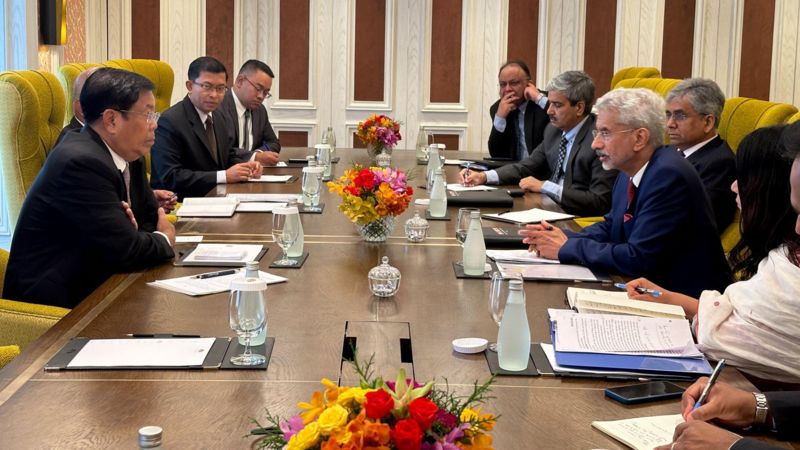
Manipur: A decade ago, the foreign ministers of India and Myanmar sat in a face-to-face meeting, where they openly discussed a very “uncomfortable” issue on the border between the two countries.
India’s S Jaishankar and Myanmar’s Than Soe met separately on the sidelines of the Foreign Ministers’ Conference of the alliance between India and several ASEAN countries called the ‘Mekong-Ganges Cooperation Mechanism’ about Manipur.
It was made clear that India was dissatisfied with the role of Myanmar in the Manipur crisis. Jaishankar. It was confirmed later in the ‘debriefing’ of journalists by the Indian Ministry of External Affairs in Delhi.
That ‘human trafficking‘ and drug smuggling from Myanmar’s territory is making the situation in Manipur more incendiary – this is the Indian government’s assessment and this was communicated to the Myanmar foreign minister that day.
In fact, the central government of India has been trying to say that the thousands of citizens of Myanmar who crossed the border in the last two-and-a-half years and came to Manipur, India, have a big role in creating instability in that Indian state.
According to the official sources, these refugees from Myanmar have come to Manipur and are encroaching on land in the hills, starting opium cultivation and running drug business and conflicts with the local residents are arising around them.
The Kuki tribe of Manipur views these refugees from Myanmar’s Chin State as their own siblings, as they consider the Kukis and Chins to be of the same ethnic origin. Apart from that, most of these Kukis and Chins are Christians.
On the other hand, this is not the case for Manipur’s majority Meitei population – refugees from Myanmar have always been viewed with suspicion by the Hindu or Vaishnavite Meiteis.
At the moment, the cornered Manipur government has also hinted many times that drug mafias are now trying to create a ‘retaliation’ because of their operations against opium plantations and drug trade in the hills of Manipur and that is a major reason for the conflict in the state.
Even Manipur Governor Anusuya Wikei, visiting a relief camp in Imphal East district a few days ago, remarked that “infiltrators from across the border” are fueling the current unrest in the state.
Later, Raj Bhavan sources issued a statement saying that what the Governor said was based on certain intelligence information.
But the fact that the ruling governments in Manipur and Delhi are pointing fingers at Myanmar or citizens from that country as one of the causes of this crisis – there are many questions about how accurate that claim is.
Lumpy policy in India?
On July 19, South Asia analyst Michael Kugelman wrote an article in ‘Foreign Policy’ magazine – in which he wants to say that India’s Myanmar policy is actually indirectly fueling the violence in Manipur.
According to him, after the military junta came back to power in Myanmar in February 2021 through a military coup, India’s arms and defense equipment sales to Myanmar have increased enormously.
Indian Defense Secretary Giridhar Araman also visited Myanmar earlier this July to discuss the arms deal.
Michael Kugelman reports, “The junta has been carrying out heavy repression and crackdowns in Myanmar’s Chin State and Sagaing region by buying weapons from India – because that’s where the insurgent resistance is strongest. In January, two bombs dropped by them fell inside India as well.”
He argued that this military operation is causing thousands of Chinese to flee to India, increasing human trafficking and drug smuggling across the border – and in turn is what has made the situation so tense in Manipur.
In fact, according to UN statistics, since the 2021 military coup, India’s arms sales to Myanmar have increased a lot.
Myanmar’s pro-democracy pressure group ‘Justin for Myanmar’ also called on India last month, saying, “Please stop arms sales to Myanmar’s junta.”
Sanjeev Baruah, an expert, author, and researcher on North-East India, also feels that the military coup that took place in Myanmar two and a half years ago is definitely having an effect on Manipur.
This former professor of politics at Bard College in New York said, “This crisis in Manipur is completely our creation.”
He said that thousands of citizens fleeing to India who were persecuted by the army in Myanmar received a warm welcome from the fraternal Mizos in Mizoram, but in Manipur, they were viewed with hatred by the majority of the Meiteis.
“Now the Indian government is not giving them any humanitarian aid, nor is it allowing any UN agency to work in the North-East.”
What is the location of Myanmar?
There has been no official comment from either Junta or the military government in neighboring Myanmar on the ethnic conflict, killings, and violence that have been going on in India’s Manipur for the past three months.
But there is an international border between Myanmar and Manipur which is about 398 km long.
This border is very relaxed, there is no barbed wire fence – movement between local people on both sides is also quite free.
After the meeting between the foreign ministers of the two countries, India made several comments on the border situation, but Myanmar remained silent.
However, the ‘Pravasi Myanmar Sarkar’ (Government in Exile) formed by the Myanmar refugees on Indian soil advises their citizens in India to stay away from the Manipur crisis.